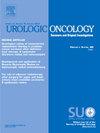Multicenter study of active surveillance for small renal masses: Real world practice pattern
IF 2.4
3区 医学
Q3 ONCOLOGY
Urologic Oncology-seminars and Original Investigations
Pub Date : 2025-05-01
DOI:10.1016/j.urolonc.2025.01.009
引用次数: 0
Abstract
Introduction
Active surveillance (AS) is a safe strategy for small renal masses (SRM) suspicious of renal cell carcinoma. In this study we analyze real world outcomes of active surveillance SRM from 5 tertiary Spanish centers, assessing clinical, radiological, and pathological characteristics, as well as therapeutic options.
Methods
A multicenter retrospective review was conducted including patients on AS from January 2012 to September 2024. We analyzed the indication for AS, initial lesion size, growth rate (GR), and progression on active surveillance. Cox regression analysis was performed to identify predictor of deferred intervention (DI).
Results
A total of 384 patients with renal tumors were included in AS, with an initial mean tumor size of 20.5mm. With a mean follow-up period of 43 months, the average GR across the cohort was 1.4 mm/y. About 15% of patients (n = 59) received active treatment (partial nephrectomy 56%, radical nephrectomy 16%, and radiofrequency 28%). Age, tumor size and tumor growth were factors correlated with delayed intervention, and only initial tumor size was correlated with GR. Pathological analysis after active treatment showed high grade clear cell carcinoma in 43.5% of cases with a GR of > 5 mm/y, as compared to 19.4% of oncocytomas in slow growing lesions. No disease progression nor cancer-specific deaths were observed in our series.
Conclusions
In our multicenter cohort, AS is a valid option for SRMs without affecting oncological outcomes, with clinical factors such as age, tumor size, GR and initial biopsy influencing decisions on intervention.
小肾肿块主动监测的多中心研究:现实世界的实践模式。
导言:主动监测(AS)是一种安全的策略,用于小肾肿块(SRM)怀疑肾细胞癌。在这项研究中,我们分析了来自西班牙5个三级中心的主动监测SRM的真实世界结果,评估了临床、放射学和病理特征,以及治疗方案。方法:对2012年1月至2024年9月的AS患者进行多中心回顾性分析。我们分析了AS的适应症、初始病变大小、生长速率(GR)和主动监测的进展。采用Cox回归分析确定延迟干预(DI)的预测因子。结果:AS共纳入384例肾脏肿瘤患者,初始平均肿瘤大小为20.5mm。平均随访时间为43个月,整个队列的平均GR为1.4 mm/年。约15%的患者(n = 59)接受了积极治疗(部分肾切除术56%,根治性肾切除术16%,射频手术28%)。年龄、肿瘤大小和肿瘤生长是延迟干预的相关因素,只有初始肿瘤大小与GR相关。积极治疗后的病理分析显示,高分级透明细胞癌的发生率为43.5%,GR为0.5 mm/y,而缓慢生长病变的癌细胞瘤的发生率为19.4%。在我们的研究中,没有观察到疾病进展或癌症特异性死亡。结论:在我们的多中心队列中,AS是SRMs的有效选择,不影响肿瘤预后,年龄、肿瘤大小、GR和初始活检等临床因素影响干预决策。
本文章由计算机程序翻译,如有差异,请以英文原文为准。
求助全文
约1分钟内获得全文
求助全文
来源期刊
CiteScore
4.80
自引率
3.70%
发文量
297
审稿时长
7.6 weeks
期刊介绍:
Urologic Oncology: Seminars and Original Investigations is the official journal of the Society of Urologic Oncology. The journal publishes practical, timely, and relevant clinical and basic science research articles which address any aspect of urologic oncology. Each issue comprises original research, news and topics, survey articles providing short commentaries on other important articles in the urologic oncology literature, and reviews including an in-depth Seminar examining a specific clinical dilemma. The journal periodically publishes supplement issues devoted to areas of current interest to the urologic oncology community. Articles published are of interest to researchers and the clinicians involved in the practice of urologic oncology including urologists, oncologists, and radiologists.

 求助内容:
求助内容: 应助结果提醒方式:
应助结果提醒方式:


